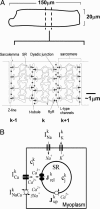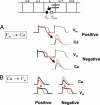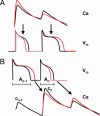Turing instability mediated by voltage and calcium diffusion in paced cardiac cells
- PMID: 16574775
- PMCID: PMC1458631
- DOI: 10.1073/pnas.0511061103
Turing instability mediated by voltage and calcium diffusion in paced cardiac cells
Abstract
In cardiac cells, the coupling between the voltage across the cell membrane (V(m)) and the release of calcium (Ca) from intracellular stores is a crucial ingredient of heart function. Under abnormal conditions and/or rapid pacing, both the action potential duration and the peak Ca concentration in the cell can exhibit well known period-doubling oscillations referred to as "alternans," which have been linked to sudden cardiac death. Fast diffusion of V(m) keeps action potential duration alternans spatially synchronized over the approximately 150-mum-length scale of a cell, but slow diffusion of Ca ions allows Ca alternans within a cell to become spatially asynchronous, as observed in some experiments. This finding raises the question: When are Ca alternans spatially in-phase or out-of-phase on subcellular length scales? This question is investigated by using a spatially distributed model of Ca cycling coupled to V(m). Our main finding is the existence of a Turing-type symmetry breaking instability mediated by V(m) and Ca diffusion that causes Ca alternans to become spontaneously out-of-phase at opposite ends of a cardiac cell. Pattern formation is governed by the interplay of short-range activation of Ca alternans, because of a dynamical instability of Ca cycling, and long-range inhibition of Ca alternans by V(m) alternans through Ca-sensitive membrane ionic currents. These results provide a striking example of a Turing instability in a biological context where the morphogens can be clearly identified, as well as a potential link between dynamical instability on subcellular scales and life-threatening cardiac disorders.
Conflict of interest statement
Conflict of interest statement: No conflicts declared.
Figures





Similar articles
-
Spatially discordant alternans in cardiac tissue: role of calcium cycling.Circ Res. 2006 Sep 1;99(5):520-7. doi: 10.1161/01.RES.0000240542.03986.e7. Epub 2006 Aug 10. Circ Res. 2006. PMID: 16902177
-
Inferring the cellular origin of voltage and calcium alternans from the spatial scales of phase reversal during discordant alternans.Biophys J. 2007 Feb 15;92(4):L33-5. doi: 10.1529/biophysj.106.100982. Epub 2006 Dec 15. Biophys J. 2007. PMID: 17172300 Free PMC article.
-
Dynamical effects of calcium-sensitive potassium currents on voltage and calcium alternans.J Physiol. 2017 Apr 1;595(7):2285-2297. doi: 10.1113/JP273626. Epub 2017 Jan 24. J Physiol. 2017. PMID: 27902841 Free PMC article.
-
Cardiac alternans and intracellular calcium cycling.Clin Exp Pharmacol Physiol. 2014 Jul;41(7):524-32. doi: 10.1111/1440-1681.12231. Clin Exp Pharmacol Physiol. 2014. PMID: 25040398 Free PMC article. Review.
-
Nonlinear dynamics of paced cardiac cells.Ann N Y Acad Sci. 2006 Oct;1080:376-94. doi: 10.1196/annals.1380.028.x. Ann N Y Acad Sci. 2006. PMID: 17132796 Review.
Cited by
-
Intracellular ion accumulation in the genesis of complex action potential dynamics under cardiac diseases.Phys Rev E. 2024 Feb;109(2-1):024410. doi: 10.1103/PhysRevE.109.024410. Phys Rev E. 2024. PMID: 38491656 Free PMC article.
-
Cardiac cellular coupling and the spread of early instabilities in intracellular Ca2+.Biophys J. 2012 Mar 21;102(6):1294-302. doi: 10.1016/j.bpj.2012.02.034. Epub 2012 Mar 20. Biophys J. 2012. PMID: 22455912 Free PMC article.
-
Non-linear dynamics of cardiac alternans: subcellular to tissue-level mechanisms of arrhythmia.Front Physiol. 2012 May 31;3:157. doi: 10.3389/fphys.2012.00157. eCollection 2012. Front Physiol. 2012. PMID: 22783195 Free PMC article.
-
Alternans and arrhythmias: from cell to heart.Circ Res. 2011 Jan 7;108(1):98-112. doi: 10.1161/CIRCRESAHA.110.223586. Circ Res. 2011. PMID: 21212392 Free PMC article. Review.
-
Mechanisms by which cytoplasmic calcium wave propagation and alternans are generated in cardiac atrial myocytes lacking T-tubules-insights from a simulation study.Biophys J. 2012 Apr 4;102(7):1471-82. doi: 10.1016/j.bpj.2012.03.007. Epub 2012 Apr 3. Biophys J. 2012. PMID: 22500747 Free PMC article.
References
Publication types
MeSH terms
Substances
Grants and funding
LinkOut - more resources
Full Text Sources

